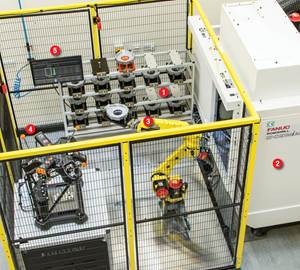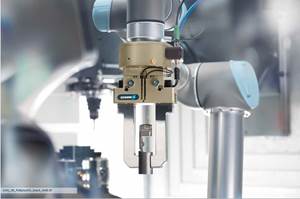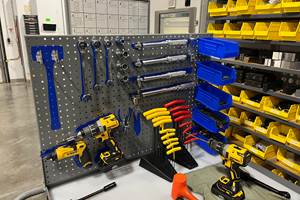The Mobile Cobots Are Coming
Otto Motors, Yaskawa America and Mobile Industrial Robots are stretching the limits of collaborative robotics for the shop floor by adding autonomous mobility.
Share






Collaborative robots, or “cobots,” may soon be not only known for their ease of programming and safety controls with part picking/placing and machine tending, but also for their ability to pick up and transport payloads around the shop floor, among human workers, completely autonomously.
That’s the idea behind such robots as ’ Otto 100 and 1500 models, which are primarily designed for material handling, but are being developed for other applications as well.
Intended to carry palletized loads, these robotic vehicles can autonomously map their surroundings for safe, intelligent pathfinding through a facility. Basically, these robots adapt technology similar to the kind seen in Google’s self-driving cars, but for indoor, industrial applications. In fact, Director of Industrial Solutions Simon Drexler says that Otto Motors “is on trend to have more autonomous miles driven than the Google driverless car.” Early adoption of the Otto concept by customers like GE and John Deere is expected to put more self-driving vehicles (SDVs) in manufacturing and distribution facilities by the end of 2016 than Google will have on outdoor roads.
In the video below, the Otto 100 (with 100-kg payload) carries a light shelving unit, while the Otto 1500 (with 1,500-kg payload) uses its lift configuration to dock with a pallet for transport.
Some video from my visit with at IMTS last month. The Otto 100 holds a shelf unit, and the Otto 1500 lifts a payload. pic.twitter.com/t8ahXexklk
— Jedd Cole (@ Work) (@mms_jeddcole) October 5, 2016
Forming a "Mental Map" for Safe, Autonomous Navigation
Just as human beings receive data about their environment and form a “mental map” to find their way, these self-driving vehicles take in data using their laser scanners and form a map for autonomous navigation. According to the company, it’s as easy as taking the robot for an initial walk around a facility (which means manually controlling the robot). The Otto 1500 uses two LiDAR sensors (one on the front and one on the rear) to scan the environment as it goes. “Once it has that reference map, it can freely navigate from any origin to any destination inside of the mapped parameters,” says Drexler. This initial reference map is uploaded to the Clearpath App, enabling users to update, edit and track it. Additional Otto robots use the same map, meaning the initial scanning process need only be performed once.
The Clearpath OS is said to enable the robots to move about using only their onboard sensors, eliminating the need for any magnetic tape, beacons or additional infrastructure (though some applications might require high-precision targets for docking, like in the video above). The same scanners that build the reference map can also identify objects and people, enabling the robot to safely stop before obstacles and dynamically figure out alternate paths to reach its destination. The Dispatch App, which enables path editing for repeated tasks as well as on-the-fly task dispatch, can be set up on a PC or tablet. The interface centrally manages a shop’s entire Otto fleet, providing a point-and-click, drag-and-drop platform for robot orders.
The Otto robots carry a NTB 56 safety certification and are designed with the idea that these will serve as a form of mobile collaborative robot, not just a point-A-to-point-B currier. Drexler says that one of its automotive customers has certified its robots for navigation on the same paths as its human workers: “Rather than treating [the robot] like a vehicle or a fork truck, they’re treating it like a member of the workforce so it can navigate and move around its human partners.”
Adding a Robot Arm and End Effector
While the robots are currently targeted at the material handling industry, there are already efforts being made to bring them into a wider set of applications. Otto Motors recently entered into a research effort with Yaskawa to develop a mobile manipulator solution, the prototype of at trade shows already.
The prototype uses the Otto 1500 with Yaskawa America MH12 robot arm and a 2-Finger 85 gripping end effector along with a wrist camera for machine vision. This produces an autonomously mobile robot arm with a 1.4-meter reach and 12-kg payload that can communicate with other machines via a wireless direct connection to a PLC.
As explained in a by Mathieu Bélanger-Barrette of Robotiq, the research project is still in development, but it seems to have potential for bin packing, process-specific manipulation and mobile machine tending.
Automating the Undefinable
Otto Motors isn’t the only developer of self-driving, autonomously navigating robots for indoor, industrial use. has also developed a small mobile robot, the MiR100, which, similar to the Otto 100, has a 100-kg payload. It can also tow loads weighing as much as 300 kg. Like the Otto 100 and 1500, it appears that the MiR100 is also capable of safe, autonomous navigation, with software compatible with PCs, tablets and smartphones.
Collaborative robots are clearly diversifying and proliferating as a more and more common way to streamline manufacturing, as was quite evident at IMTS. Drexler, referring to his previous experience with an automation supplier, recalls: “One of the things we used to say is, if you can define it, you can automate it.” What technology like Otto Motors’ and Mobile Industrial Robots’ SDVs is showing is that the limits of what can be automated is now stretching beyond what can be well defined to include what has heretofore been considered undefinable.
This blog post was originally published at .
Related Content
5 Stages of a Closed-Loop CNC Machining Cell
Controlling variability in a closed-loop manufacturing process requires inspection data collected before, during and immediately after machining — and a means to act on that data in real time. Here’s one system that accomplishes this.
Read MoreLean Approach to Automated Machine Tending Delivers Quicker Paths to Success
Almost any shop can automate at least some of its production, even in low-volume, high-mix applications. The key to getting started is finding the simplest solutions that fit your requirements. It helps to work with an automation partner that understands your needs.
Read MoreTranslating a Prototyping Mindset to Production
The experimental mindset that benefited BDE Manufacturing Technologies as a prototype job shop has given it an adaptable edge as a production facility.
Read More3 Ways Artificial Intelligence Will Revolutionize Machine Shops
AI will become a tool to increase productivity in the same way that robotics has.
Read MoreRead Next
Last Chance! 2025 Top Shops Benchmarking Survey Still Open Through April 30
Don’t miss out! 91ÊÓƵÍøÕ¾ÎÛ's Top Shops Benchmarking Survey is still open — but not for long. This is your last chance to a receive free, customized benchmarking report that includes actionable feedback across several shopfloor and business metrics.
Read MoreAMRs Are Moving Into Manufacturing: 4 Considerations for Implementation
AMRs can provide a flexible, easy-to-use automation platform so long as manufacturers choose a suitable task and prepare their facilities.
Read MoreMachine Shop MBA
Making Chips and 91ÊÓƵÍøÕ¾ÎÛ are teaming up for a new podcast series called Machine Shop MBA—designed to help manufacturers measure their success against the industry’s best. Through the lens of the Top Shops benchmarking program, the series explores the KPIs that set high-performing shops apart, from machine utilization and first-pass yield to employee engagement and revenue per employee.
Read More




















